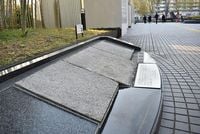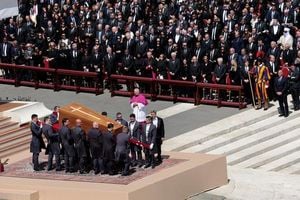In a poignant reminder of the past, three paving stones exposed to the heat rays of the atomic bomb in Hiroshima have been placed in front of the Tokorozawa City Hall in Saitama Prefecture. These stones, donated by Hiroshima City 41 years ago, bear the inscription "No more Hiroshima" and serve as a powerful symbol for peace education and the abolition of nuclear weapons.
The mayor of Tokorozawa at the time of the donation, Yasunosuke Mutou, explained during a city council meeting that "it was possible to receive the paving stones from the Hiroshima City Hall building that was being dismantled" and decided to install them "for peace education and peace learning." This year marks the 80th anniversary of the end of World War II, a significant milestone that underscores the importance of remembering the lessons of history.
On August 6, 1985, a delegation of 18 individuals, including the mayor and city council representatives from Tokorozawa, participated in the Hiroshima Peace Memorial Ceremony. This tradition continues, with junior and senior high school students being dispatched as city representatives to honor the memory of the past and promote peace.
Although the two cities have deepened their exchanges over the years, there were no immediate ceremonies held after the installation of the atomic bombed stones. However, as time passed, voluntary flower offerings from citizens and requests to the city prompted a shift. Since 2004, Tokorozawa City employees have been offering flowers and water at the site every August, coinciding with the anniversary of the bombing.
On August 6, 2024, the 'Citizens' Peace Memorial Ceremony' was held for the 15th time, with around 100 participants gathering to remember the past and advocate for a future without nuclear weapons. Mr. Shigeki Oyama, a member of the executive committee that organizes the ceremony, expressed his hopes for the future, stating, "By using it for peace education for children, it will be passed on to the next generation." He added, "The realization of a world without nuclear weapons will probably happen in the next generation, sadly. I want to create an opportunity to exchange opinions with the younger generation about the paving stones and think about how to deal with the issue of nuclear weapons."
However, despite the significance of these stones, many citizens are unaware of their presence. Reports indicate that numerous passersby have said they "didn't know" the atomic bombed stones were there. This highlights a critical challenge in the ongoing efforts to educate the public about the importance of peace and the historical context surrounding these artifacts.
The paving stones consist of three pieces: one approximately 70 cm square and two approximately 60 cm square. They were donated to commemorate the 35th anniversary of Tokorozawa City administration, inspired by a lecture given by the director of the Hiroshima Peace Memorial Museum. Following the completion of the new city hall in 1986, the stones were installed at the west entrance of the building.
According to Hiroshima City, these paving stones were originally part of the forecourt of the old city hall, located about 1 km from the hypocenter of the atomic bomb. The city has donated these stones to various organizations and municipalities that wish to use them for promoting the abolition of nuclear weapons and fostering lasting world peace. To date, there have been 101 donations both domestically and internationally, with the stones being utilized as building materials, peace monuments, and educational tools.
In addition to Tokorozawa, there are three other locations in Saitama Prefecture where similar stones have been placed: in front of Honjo City Hall, at the Prefectural Peace Museum in Higashimatsuyama City, and at Konoyama High School in Konoyama Town. Each site serves as a reminder of the past and a beacon for future generations to learn about the importance of peace.
The ongoing efforts by citizens to engage the younger generation in discussions about nuclear disarmament and peace are crucial, especially as the number of individuals who directly experienced the war continues to dwindle. As Mr. Oyama noted, the future of nuclear abolition rests in the hands of the next generation, making it imperative that they are educated about the historical significance of these stones and the broader implications of nuclear weapons.
As the 80th anniversary of the end of World War II approaches, it is vital for communities to reflect on the past and strive towards a peaceful future. The paving stones at Tokorozawa City Hall stand not only as a memorial to those who suffered but also as a call to action for current and future generations to advocate for a world free of nuclear weapons.
In conclusion, the presence of the atomic bombed stones in Tokorozawa serves as a powerful reminder of the past and a catalyst for ongoing discussions around peace education. It is essential for community members to engage with this history, ensuring that the lessons learned are passed down to future generations.




